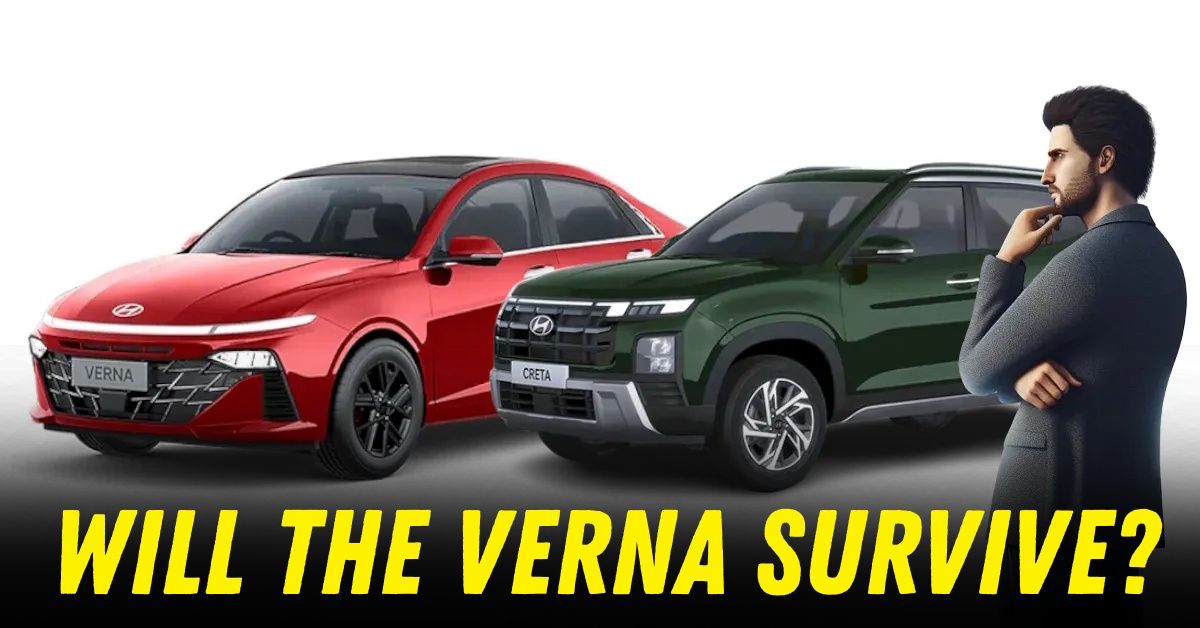2 Out of 3 Cars Sold By Hyundai Were SUVs: Where Does That Leave Verna?


Hyundai Motor India’s latest sales numbers tell a clear story: India’s love affair with SUVs is now official—it has been for some time actually. In FY2024–25, a record 68.5% of all Hyundai vehicles sold in India were SUVs—up from 63.2% the previous year. That means two out of every three Hyundais leaving showrooms are high-riding, feature-rich SUVs. The shift is about more than just body style. Over half (53.2%) of Hyundai’s cars sold now come with a sunroof, a feature once reserved for luxury cars. Sales of models equipped with Advanced Driver Assistance Systems (ADAS) have doubled, reflecting a new, tech-hungry, aspirational customer base.
But in a market that’s so clearly tilting towards SUVs loaded with premium features, what happens to the classic sedan—especially Hyundai’s own Verna, once the go-to choice for those seeking style and performance?
The numbers behind Hyundai’s SUV surge are striking. In just one year, the share of SUVs in Hyundai’s domestic sales jumped from 63.2% to 68.5%. The brand’s SUV lineup is broad and deep, ranging from the entry-level Exter and Venue, to the best-selling Creta, the three-row Alcazar, the premium Tucson, and the all-electric IONIQ 5.
This SUV push is closely tied to the rise in demand for features like sunroofs (now available in 12 out of 14 Hyundai models), ADAS (offered in 9 models), multiple powertrain choices (petrol, diesel, turbo, CNG, EV), and a variety of transmissions from AMT to DCT and iVT.
Tarun Garg, Hyundai’s COO, summed it up:
The doubling of ADAS variant contribution and growing popularity of sunroof-equipped models reflects the rising aspirations of our customers and their readiness to embrace global technologies…offering products that are future-ready, feature-rich, and engineered for India.
Where does this leave the Verna? The Verna remains Hyundai’s flagship sedan, positioned as a tech-rich, stylish, and performance-oriented mid-size car. The latest generation, launched in 2023, brought bold new styling, a turbo-petrol engine, and features like a sunroof, ADAS, ventilated seats, and a premium Bose sound system.
Yet, the numbers tell a sobering tale. In March 2025, the Verna sold 1,364 units—respectable, but dwarfed by the Creta’s 18,059 units in the same month. Even as the Verna does fine by mid-size sedans standards [only VW Virtus is ahead of it], its segment is shrinking, with sedans now making up just 8% of India’s car market.
Still, the Verna offers things SUVs can’t: a lower centre of gravity for better ride and handling, a punchy turbo-petrol engine, and a sleeker, more aerodynamic design. For driving enthusiasts and those who prefer the classic sedan silhouette, the Verna remains a compelling choice.
The Verna still appeals to a niche of buyers who value driving dynamics and sedan sophistication. Hyundai has kept it up-to-date with features like ADAS, sunroof options, and premium interiors. But as sedan volumes shrink, there’s a risk that investment in new variants or updates will slow down.
Hyundai faces a choice: reposition the Verna as a low-volume flagship for enthusiasts, explore an electric Verna to ride the EV wave, or gradually let it fade away as it did with the Elantra and Accent. For now, there’s no N Line performance variant planned, and Hyundai’s focus is squarely on SUVs and EVs.
The Indian car buyer is not just moving to SUVs—they’re demanding premium, tech-rich experiences in every segment. Hyundai’s success with sunroofs, ADAS, and connected tech is a response to this shift. Sedans like the Verna may survive as niche offerings, valued by loyalists and city buyers, but the big bets and big investments will follow the SUV path.
SUVs have taken over Hyundai’s strategy and the Indian market at large. The Verna remains an important nameplate, but it’s fighting an uphill battle against a tide of SUV demand. Its future will depend on Hyundai’s willingness to keep it relevant—perhaps as a tech-forward, enthusiast’s sedan in a world obsessed with height, presence, and the latest features. For now, the Verna fights on, but the road ahead is undeniably steep.